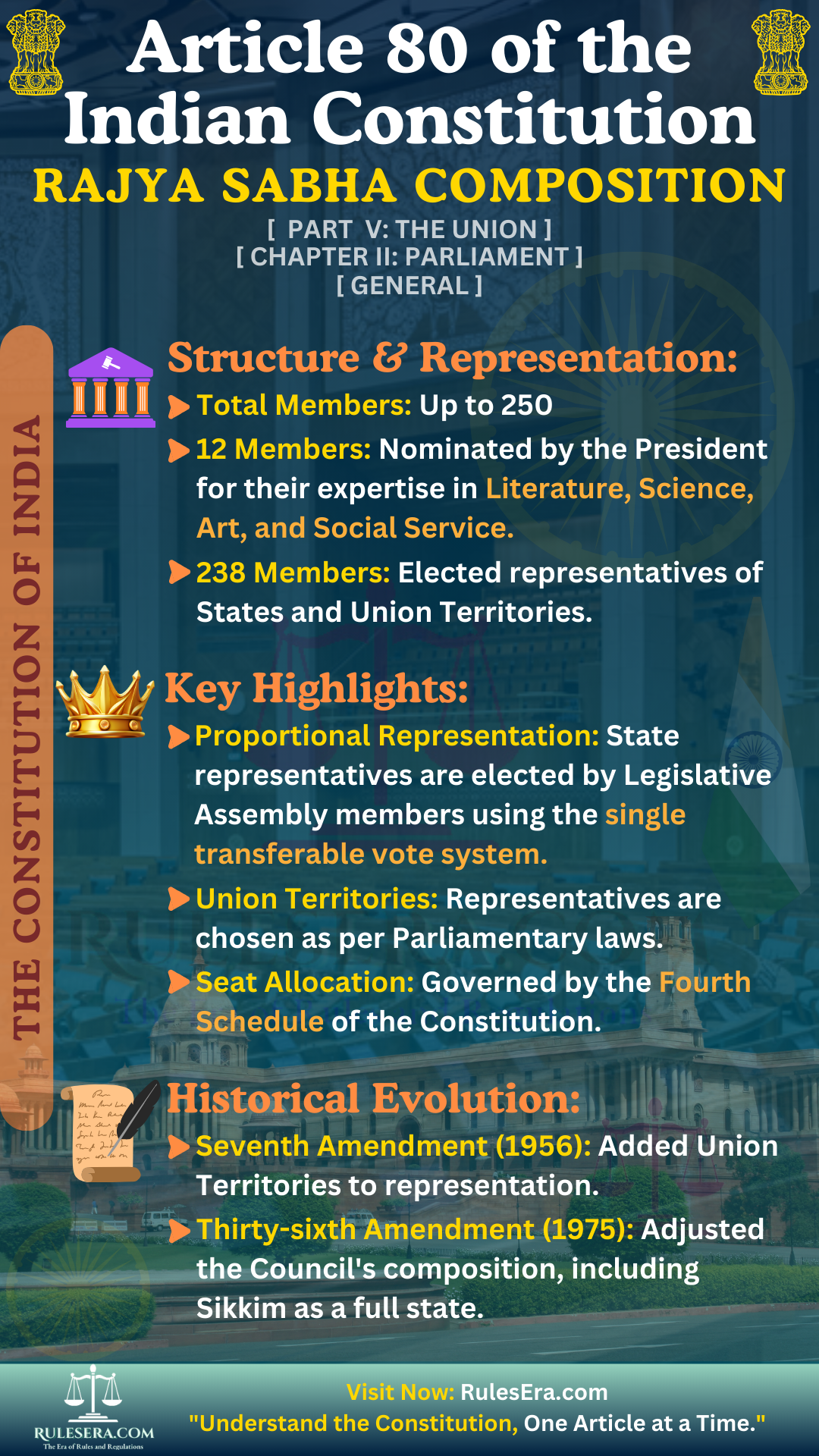Part V: The Union
Chapter II: Parliament
Article 80: Composition of the Council of States

--- Original Article ---
Original Article: The Council of States shall consist of—
- (a) twelve members to be nominated by the President in accordance with the provisions of clause (3);
- (b) not more than two hundred and thirty-eight representatives of the States and Union territories.
Explanations
Article 80 of the Indian Constitution outlines the composition and structure of the Council of States, also known as the Rajya Sabha, which serves as the upper house of the Parliament of India. This article defines the number of members, their method of election, and the roles they represent. The Council of States plays a crucial role in the legislative process, ensuring representation for states and union territories in national decision-making.
Clause-by-Clause Explanation
Clause (1): Composition of the Council of States
Sub-clause (a) specifies that the President of India nominates twelve members to the Council of States, focusing on individuals with expertise in literature, science, art, and social service.
Sub-clause (b) states that there shall not be more than 238 representatives from the states and union territories, ensuring balanced representation.
Clause (2): Allocation of Seats
The Fourth Schedule of the Constitution provides guidelines on how seats are allocated to each state and union territory. This schedule is designed to ensure a proportionate representation based on population.
Clause (3): Nomination by the President
The President has the authority to nominate members with significant achievements or expertise, thereby enhancing the legislative discourse with specialized knowledge in areas like literature, science, art, and social service.
Clause (4): Election of State Representatives
Representatives from the states are elected by members of each state's Legislative Assembly using proportional representation through a single transferable vote. This system helps maintain a fair and representative selection process, reflecting the diverse opinions within each state.
Clause (5): Representation of Union Territories
Representatives from Union Territories are chosen through a method determined by Parliament, allowing flexibility in representing territories with varying administrative needs.
Amendments and Historical Significance
The Rajya Sabha was established to provide states with a platform to participate in national legislation, emphasizing a federal structure. The Council has evolved through amendments to accommodate India’s growing number of states and union territories, thus maintaining a balanced and inclusive approach.
Real-Life Example
- Notable nominees such as scientists, artists, and social workers contribute to policy discussions. Dr. M.S. Swaminathan, a prominent agricultural scientist, has provided insights into agrarian issues through his role in the Rajya Sabha.
- The nomination of film actor Rekha brought attention to cultural issues, illustrating how diverse nominations can broaden legislative discussions.
Legislative History
Article 80 of the Indian Constitution, originally drafted as clauses (1) to (4) of Article 67, was extensively deliberated on January 3rd and 4th, 1949, and revisited on October 13th and 17th, 1949.
Debates and Amendments
In the Constituent Assembly debates, Prof. K. T. Shah argued for the deletion of Clause (2), contending that even minimal nomination undermines the principle of a fully elected body and disrupts its structure. Additionally, Shah found the classification of fields like art, science, and education illogical and overlapping. Although Dr. Ambedkar's amendment aimed to simplify this, Shah believed it still did not address the core issues.
Shri Lokanath Misra proposed reducing the Council of States' membership from 250 to 150. He argued that a smaller number would be more effective, as larger assemblies struggle to find enough qualified, actively participating members.
Shri Lakshminarayan Sahu opposed the nomination of legislative members, fearing it could lead to favoritism accusations against the President. He argued for electing talented individuals and suggested adopting an advisory board system to provide expert counsel instead of nominations.
Frequently Asked Questions (FAQs):
The members are either nominated by the President (12 members) for their expertise or elected by the Legislative Assemblies of the states and Union Territories based on proportional representation.
The President nominates 12 members to the Council of States, ensuring that individuals with expertise in literature, science, art, and social service contribute to national legislation.
Representatives from Union Territories are selected through a method determined by Parliament, which may vary according to the specific administrative needs of each territory.
Yes, Article 80 has been amended multiple times, including the Seventh and Thirty-fifth Amendments, which addressed changes in the representation of Union Territories and the status of Sikkim.